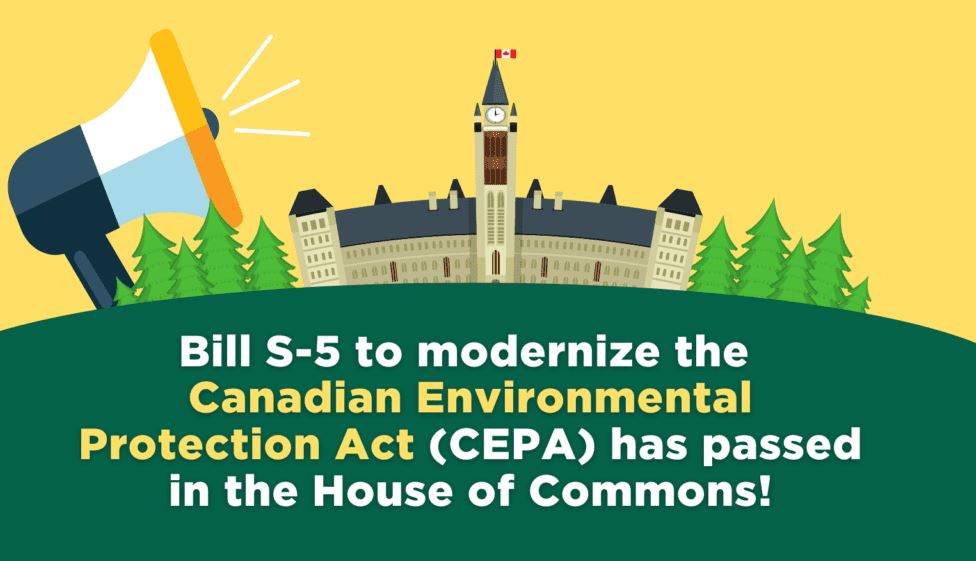Ottawa – Introduced in February 2022, Bill S-5, Strengthening Environmental Protection for a Healthier Canada Act, received Royal Assent on June 13. The Bill modernizes the Canadian Environmental Protection Act, 1999 (CEPA) and represents the first set of comprehensive amendments to CEPA since it was enacted over 20 years ago.
With this Bill, the Government of Canada is delivering on its commitment to strengthen CEPA and recognize, for the first time in federal law, that every individual in Canada has a right to a healthy environment. A summary of the amendments included in Bill S-5 are outlined below.
A right to a healthy environment
Bill S-5 requires that decisions made under CEPA respect the right to a healthy environment.
Over the next two years, the Government will develop an implementation framework to set out how that right will be considered in administering the Act. That framework will explain how the right will account for principles such as environmental justice, intergenerational equity, and non-regression. It will also describe any other relevant factors to consider in interpreting and applying the right and determining its reasonable limits.
- Environmental justice includes the avoidance of adverse effects that disproportionately affect vulnerable populations.
- Non-regression includes the continuous improvement in environmental protection.
- Intergenerational equity includes the importance to meet the needs of the present generation without compromising the ability of future generations to meet their own needs.
The framework will be developed in consultation with interested Canadians. The ministers of Environment and Climate Change and of Health will report on the implementation framework annually. The framework will also enable continuous improvement in light of experience and as views evolve.
The amendments also require that research, studies, or monitoring activities be conducted to support the Government in protecting the right.
The amendments also confirm the Government’s commitment to implement the United Nations Declaration on the Rights of Indigenous Peoples and incent action on reconciliation through a requirement to report annually on consultations, findings, recommendations, or measures taken in that regard.
Protecting vulnerable populations
Implementation of the right to a healthy environment under CEPA will include work to identify populations that may be disproportionately impacted due to greater susceptibility or higher exposure to environmental and health risks, leading to more informed and protective environmental and health standards.
The amendments also expressly require the Government to administer the Act in ways that minimize risks to the health of vulnerable populations.
In subsection 3(1) of the Act, the amendments define a vulnerable population as “a group of individuals within the Canadian population who, due to greater susceptibility or greater exposure, may be at an increased risk of experiencing adverse health effects from exposure to substances.” These populations may include pregnant people, children, people in poor health, workers, and those living in areas where levels of pollution are particularly high.
To better protect people who are more susceptible or highly exposed to harmful substances, changes to CEPA provide that the Government has a duty under the Act to protect the environment and the health of all Canadians, including vulnerable populations. The changes also require the ministers of Environment and Climate Change and of Health to consider available information regarding vulnerable populations and vulnerable environments in risk assessments. To maximize the availability of that information, the amendments require the Government to conduct research and studies, including biomonitoring surveys, specifically in relation to the role of substances in illnesses or in health problems, which may relate to vulnerable populations. The amendments also enable geographically targeted regulations to better support the protection of communities at risk from local sources of pollution.
Assessing real-life exposures
In Canada and elsewhere, the general approach has been to assess substances for risks in isolation. However, Canadians and the environment are exposed to multiple substances from many different sources often at the same time and over a lifetime.
Recognizing that the science of assessing cumulative effects is still evolving, amendments to CEPA require that the Ministers of Environment and Climate Change and of Health consider available information about the cumulative effects on the environment and health that may result from exposure to a substance in combination with exposure to other substances when conducting and interpreting the results of risk assessments.
A new Plan of Chemicals Management Priorities
The Government will develop a new Plan of Chemicals Management Priorities to assess and better understand and protect Canadians and the environment from chemicals of concern.
In 1999, CEPA required prioritization of the 23,000 substances already in commerce in Canada based on specific criteria related to their bioaccumulation, persistence, inherent toxicity, and the greatest potential for exposure. This process identified approximately 4,300 chemicals as priorities that met one or more of these criteria. The resulting process to assess these substances has largely been completed.
With new chemicals being developed, new uses for existing chemicals, increasingly complex supply chains, and emerging science about risks including cumulative effects, the CEPA amendments require the Government to establish a new plan to prioritize the ongoing assessment of risks from chemicals. This plan will include timelines, a strategy to reduce reliance on vertebrate animal testing, consider class-based assessment approaches as a means of avoiding regrettable substitutions, as well as labelling and other means to provide meaningful information to the public. The amendments also require that this plan be reviewed at least every eight years.
Supporting the shift to safer chemicals
To support the shift to safer chemicals, the Government recognizes that it is important to encourage the use of product designs, processes, and chemicals that are safe for the environment and human health.
In addition to changes to risk assessment and risk management activities, CEPA amendments require the Minister of Environment and Climate Change to maintain a Watch List—a list of substances that can pose a risk and thereby meet the criteria in Section 64 of CEPA if, for example, uses change or exposure increases. The Watch List will help importers, manufacturers, and Canadian consumers to select safer alternatives and avoid regrettable substitutions—replacing one problem chemical with another that, in turn, becomes a problem.
Increased transparency in decision-making
The amendments to CEPA allow Canadians to request that a chemical be assessed and require the Ministers of Environment and Climate Change and of Health to consider and respond to any such requests.
The amendments also require that the Government communicate anticipated timelines for completing risk assessments and for proposing subsequent risk management actions when a substance is found to meet the criteria to require risk management.
Industry will also be required to provide a rationale to support requests for the confidentiality of business information, and the Ministers will be required to review and validate a statistically representative sample of these requests and report on the results. In addition, the amendments establish the circumstances under which the Ministers may disclose the explicit names of masked substances or living organisms.
A stronger regime for toxic substances that pose the highest risk
Amendments to CEPA create a stronger regime for controlling the subset of toxic substances that pose the highest risk to human health or the environment.
For substances that are determined to be toxic under CEPA and that meet the new additional criteria of posing the highest risk, the amendments to CEPA require that the Minister of Environment and Climate Change and the Minister of Health give priority to prohibiting activities involving these substances. The criteria for these substances will be set out in regulations and will include persistence, bioaccumulation, carcinogenicity, mutagenicity, and reproductive toxicity. These regulations will be developed in consultation with stakeholders.
Giving priority to prohibition can lead to different scenarios: the substances can be phased out entirely; activities or releases of concern can be prohibited; or all new uses can be prohibited, unless it can be demonstrated that there are no safer alternatives, and the use can be undertaken safely.
To reflect this new approach, Schedule 1 is divided into two parts. Part 1 contains toxic substances that pose the highest risk, for which CEPA will prioritize the prohibition of activities and releases of concern. Part 2 contains all other CEPA-toxic substances.
These amendments maintain the fundamental risk-based approach under CEPA, which ensures that the Government focuses on the risks posed by substances based on their inherent characteristics and their actual or potential releases and exposures.
Risk assessments of new living organisms under Part 6 of the Act
Amendments to CEPA require the Ministers of Environment and Climate Change and of Health to consult interested persons when assessing new living organisms that are vertebrate animals or otherwise prescribed by regulation.
Reducing reliance on animal testing
Amendments to CEPA recognize the global effort to reduce reliance on the use of vertebrate animal testing when assessing the risks from substances. These amendments require the Government to support the development and use of scientifically justified alternative methods and strategies to replace, reduce, or refine the use of vertebrate animals in toxicity testing.
Changes to the Food and Drugs Act to strengthen the environmental risk assessment and risk management of drugs
Amendments to the Food and Drugs Act expand the Minister of Health’s ability to manage environmental risks resulting from drugs, and also provides the Minister the ability to develop modernized environmental risk assessment and risk management regulations for drugs under the Food and Drugs Act.
Moving forward
The Government of Canada will get to work on implementing the modernized Act. Implementation work will include engaging Canadians in developing an implementation framework on the right to a healthy environment under CEPA and a Plan of Chemicals Management Priorities.
The Government will also continue to review other potential changes to CEPA to ensure that it continues to provide an effective legal foundation for protecting the environment and human health.








